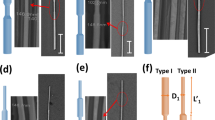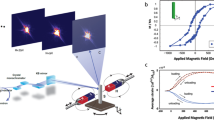Abstract
The magnetocaloric effect (MCE) in cylindrical nickel and iron nanowires containing a domain wall (DW) was investigated. A negative MCE was found out in these systems in a weak magnetic field, caused by thermal motion of the DW. It is shown that this phenomenon enhances with reduction of the magnetization of nanowires. For example, a decrease in magnetization by 50% in nickel or by 41.2% in iron nanowire leads to increment of their critical diameters (in the same magnetic field) by 48 and 27.5%, respectively. It is found that negative MCE makes it possible to change the initial temperature of 103–104 compacted nanowires by ~ 1 K. This result is of practical interest in the context of developing technologies based on the thermodynamic properties of nickel and iron nanowires with DW.





Similar content being viewed by others
References
Bruck E (2018) Handbook of magnetic materials: magnetic nanowires and nanotubes. Elsevier, Amsterdam, p 27
Contreras MF, Sougrat R, Zaher A, Ravasi T, Cosel (2015) Non-chemotoxic induction of cancer cell death using magnetic nanowires. Int J Nanomed 10:2141
Ferguson CA, MacLaren DA, McVitie S (2015) Metastable magnetic domain walls in cylindrical nanowires. JMMM 381:457
Hong W, Lee S, Chang HJ, Lee ES, Cho Y (2016) Multifunctional magnetic nanowires: A novel breakthrough for ultrasensitive detection and isolation of rare cancer cells from non-metastatic early breast cancer patients using small volumes of blood. Biomaterials 106:78
Loreto RP (2018) Topological states applied to spintronics devices. Vicosa Minas Gerais, Brazil
McGary PD, Tan L, Zou J, Stadler B, Downey PR, Flatau AB (2006) Magnetic nanowires for acoustic sensors (invited). J Appl Phys 99(8):08B310
Nana ABA, Marimuthu T, Kondiah PPD, Choonara YE, Du Toit LC, Pillay V (2019) Multifunctional magnetic nanowires: design, fabrication, and future prospects as cancer therapeutics. Cancers 11(12):1956
Parkin SSP, Hayashi M, Thomas L (2008) Magnetic domain-wall racetrack memory. Science 320:190
Piraux L (2020) Magnetic nanowires. Appl Sci 10:1832
Shevchenko AB (2018) Macroscopic quantum effects in domain boundaries of the uniaxial ferromagnetic films with the strong magnetic anisotropy. Progress Phys Met 2:115
Shevchenko AB, Barabash MY (2016) Quantum oscillations of interacting nanoscale structural inhomogeneities in domain wall of magnetic stripe domain. Nanoscale Res Lett 11:473
Shevchenko AB, Barabash MY (2019a) Heat capacity of ferrite-garnet nanowire with domain wall. Phys B Cond Matter 556:114
Shevchenko AB, Barabash MY (2019b) One through the other tunneling of the “Kink”—type solitons in domain wall of ferromagnetic film. Res Phys 13:102294
Shevchenko AB, Barabash MY (2019c) Quantum colliding of nanoscale solitons in domain wall of magnetic stripe domain. Appl Nanosci 9:595
Vonsovskij SV (1971) Magnetizm. Moscow, Nayka: Magnetism; 1971. In Russian
Funding
The work was also supported by the National Academy of Sciences of Ukraine within the budget program KΠKBK 6541230 “Support for the development of priority areas of scientific research”. The work was also supported by National Academy of Sciences of Ukraine within the budget science theme “Physical properties of self-organization and special features of the macroscopic quantum phenomena in low-dimensional systems of organic semiconductors and transition metals”.
Author information
Authors and Affiliations
Contributions
ABS and MYB took part in the formulation of problems and ways to solve it. MYB participated in the task and designed according to the requirements of article publication. Both authors read and approved the final manuscript.
Corresponding author
Ethics declarations
Conflict of Interest
The authors declare that they have no conflict of interest.
Ethics approval
The authors of the article work together, the result is original and has never been published before. In this article authors present their original research results and is it authentic copy.
Additional information
Publisher's Note
Springer Nature remains neutral with regard to jurisdictional claims in published maps and institutional affiliations.
Rights and permissions
About this article
Cite this article
Shevchenko, A.B., Barabash, M.Y. Magnetocaloric effect in nickel and iron nanowires with a domain wall. Appl Nanosci 12, 343–348 (2022). https://doi.org/10.1007/s13204-020-01649-8
Received:
Accepted:
Published:
Issue Date:
DOI: https://doi.org/10.1007/s13204-020-01649-8




